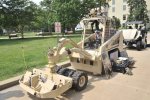Even though he gets on my nerves and he and never agree on anything, he is absolutely right on this one. 9/11 was not an inside job. There are mountains of evidence to prove this but these so-called truthers are not interested in the truth
The Affliction Of Conspiracy Theorists
- Thread starter Sinnerman
- Start date
-
Christian Chat is a moderated online Christian community allowing Christians around the world to fellowship with each other in real time chat via webcam, voice, and text, with the Christian Chat app. You can also start or participate in a Bible-based discussion here in the Christian Chat Forums, where members can also share with each other their own videos, pictures, or favorite Christian music.
If you are a Christian and need encouragement and fellowship, we're here for you! If you are not a Christian but interested in knowing more about Jesus our Lord, you're also welcome! Want to know what the Bible says, and how you can apply it to your life? Join us!
To make new Christian friends now around the world, click here to join Christian Chat.
Well at least you're spamming the thread with videos that I know I at least won't watch.
Secretly, he thinks it was an inside job too, and by posting all these vids and info he's trying to convince himself that it wasn't.. lol .. He's a man who definitely has to prove he's right and only he, is right..
J
That's perfect. Then you can say something like you are totally unaware of any eye witnesses to flight 77 flying into the pentagon, while at the same time tell others how you carefully dig into any and all conspiracies seeking the truth about them. You have all the characteristics of a lost cause conspiracy theorist. You get a cookie.
one thing thats hard to argue, when you follow the pattern of these types of events throughout history you always have the same result, more power given to the few, loss of freedom and liberties for the many. funny how it always, always, ALWAYS!! works out like that.
Be that as it may. There are a lot of experts that also question the official account. Balance my friend.....balance. One man on the internet ain't gonna change that.
and what of all the "eye witnesses" that were there and say they saw no plane, see how it goes back and forth, back and forth.
one thing thats hard to argue, when you follow the pattern of these types of events throughout history you always have the same result, more power given to the few, loss of freedom and liberties for the many. funny how it always, always, ALWAYS!! works out like that.
one thing thats hard to argue, when you follow the pattern of these types of events throughout history you always have the same result, more power given to the few, loss of freedom and liberties for the many. funny how it always, always, ALWAYS!! works out like that.
In case some of you conspiracy folks need help, this is what evidence looks like.
Re: still think 9 11 was a conspiracy?
Re: still think 9 11 was a conspiracy?
9-11 Review: ERROR: 'Pentagon Attack Maneuvers Preclude a 757'
ERROR: 'Pentagon Attack Maneuvers Preclude a 757'
A fact frequently cited as evidence that the aircraft that attacked the Pentagon on 9/11/01 was not Flight 77, a Boeing 757, is that the aircraft tracked by air traffic controllers made a spectacular spiral dive, losing 7000 feet and turning 270 degrees in about 2.5 minutes -- a maneuver alleged to be impossible for a 757. A September 12, 2001 CBS News report described the maneuver:
Radar shows that Flight 77 did a downward spiral, turning almost a complete circle and dropping the last 7000 feet in two-and-a-half minutes.
Air traffic controller Danielle O'Brien told ABC News that the maneuver was not one expected of a jetliner:
The speed, the maneuverability, the way that he turned, we all thought in the radar room, all of us experienced air-traffic controllers, that that was a military plane. [SIZE=-1][SUP]1 [/SUP] [/SIZE]
However, the fact that the plane was being flown in a manner not typical for a jetliner does not mean it was not a jetliner. A 757 is capable of rather extreme maneuvers: It is capable of taking off on one engine, and can execute pitch accelerations of over 3.5 Gs (gravities) as demonstrated by the following incident report of an IcelandAir 757-200:
[SIZE=-1] REPORT 7/2003 - Date: 22 January 2003
serious incident to icelandair BOEING 757-200 at oslo airport gardermoen norway 22 january 2002
...
1.1.14.5 At this time the First Officer called out PULL UP! - PULL UP!. The GPWS aural warnings of TERRAIN and then TOO LOW TERRAIN were activated. Both pilots were active at the control columns and a maximum up input was made. A split between left and right elevator was indicated at this time. It appears the split occurred due to both pilots being active at the controls. The pilots did not register the aural warnings. During the dive the airspeed increased to 251 kt and the lowest altitude in the recovery was 321 ft radio altitude with a peaked load factor of +3.59 gs. [/SIZE] [SIZE=-1][SUP]2 [/SUP] [/SIZE]
How does this apply to the 2.5 minute 270-degree spiral turn? The G forces produced by such a turn can be calculated using the following formula.
RCF = 0.001118 * r * N^2 where RCF = Relative Centrifugal Force (gravities) r = rotation radius (meters) N = rotation speed (revolutions per minute) If the plane were traveling at 400 miles per hour it would travel 16.666 miles, or 26,821 meters, in 2.5 minutes. Assuming it was traveling in a circular arc, it would trace out 3/4ths of a circle with a 35,761-meter circumference, giving a rotation radius of 5,691 meters and rotation speed of 0.3 rotations per minute. Plugging those values into the above equation, we obtain a centrifugal force of 0.5726 Gs -- hardly a problem for a 757 whose rated G limits are over two. Final Approach
Also cited as evidence against 757 involvement in the attack is the shallow descent angle of the aircraft as it made its final approach of the Pentagon. Photographs show no signs of gouging of the lawn by a 757's low-hanging engines, even though direct impact damage was limited to the first and second floors of the building. How could such a large aircraft be flown so close to the ground, and with such precision?
Two distinct questions are implicit in the previous one.
Hani Hanjour may not have been up to the task, but a 757's flight control computer seems sufficient. It's equipped with radar altimeters and accurate GPS monitors for precise altitude and position tracking. It can analyze and respond to conditions hundreds of times per second. Examples of the extreme capabilities of fly-by-wire systems are reverse swept-wing aircraft, which are inherently unstable and require rapid adjustment of the plane's control surfaces. [HR][/HR]References
[SIZE=-1]1. Air Traffic Controllers Recall Sept. 11, ABCNews, 10/24/01 [cached]
2. Aircraft Incident Report, Norwegian Accident Investigation Board, 1/22/02[/SIZE]
ERROR: 'Pentagon Attack Maneuvers Preclude a 757'
A fact frequently cited as evidence that the aircraft that attacked the Pentagon on 9/11/01 was not Flight 77, a Boeing 757, is that the aircraft tracked by air traffic controllers made a spectacular spiral dive, losing 7000 feet and turning 270 degrees in about 2.5 minutes -- a maneuver alleged to be impossible for a 757. A September 12, 2001 CBS News report described the maneuver:
Radar shows that Flight 77 did a downward spiral, turning almost a complete circle and dropping the last 7000 feet in two-and-a-half minutes.
Air traffic controller Danielle O'Brien told ABC News that the maneuver was not one expected of a jetliner:
The speed, the maneuverability, the way that he turned, we all thought in the radar room, all of us experienced air-traffic controllers, that that was a military plane. [SIZE=-1][SUP]1 [/SUP] [/SIZE]
However, the fact that the plane was being flown in a manner not typical for a jetliner does not mean it was not a jetliner. A 757 is capable of rather extreme maneuvers: It is capable of taking off on one engine, and can execute pitch accelerations of over 3.5 Gs (gravities) as demonstrated by the following incident report of an IcelandAir 757-200:
[SIZE=-1] REPORT 7/2003 - Date: 22 January 2003
serious incident to icelandair BOEING 757-200 at oslo airport gardermoen norway 22 january 2002
...
1.1.14.5 At this time the First Officer called out PULL UP! - PULL UP!. The GPWS aural warnings of TERRAIN and then TOO LOW TERRAIN were activated. Both pilots were active at the control columns and a maximum up input was made. A split between left and right elevator was indicated at this time. It appears the split occurred due to both pilots being active at the controls. The pilots did not register the aural warnings. During the dive the airspeed increased to 251 kt and the lowest altitude in the recovery was 321 ft radio altitude with a peaked load factor of +3.59 gs. [/SIZE] [SIZE=-1][SUP]2 [/SUP] [/SIZE]
How does this apply to the 2.5 minute 270-degree spiral turn? The G forces produced by such a turn can be calculated using the following formula.
RCF = 0.001118 * r * N^2 where RCF = Relative Centrifugal Force (gravities) r = rotation radius (meters) N = rotation speed (revolutions per minute) If the plane were traveling at 400 miles per hour it would travel 16.666 miles, or 26,821 meters, in 2.5 minutes. Assuming it was traveling in a circular arc, it would trace out 3/4ths of a circle with a 35,761-meter circumference, giving a rotation radius of 5,691 meters and rotation speed of 0.3 rotations per minute. Plugging those values into the above equation, we obtain a centrifugal force of 0.5726 Gs -- hardly a problem for a 757 whose rated G limits are over two. Final Approach
Also cited as evidence against 757 involvement in the attack is the shallow descent angle of the aircraft as it made its final approach of the Pentagon. Photographs show no signs of gouging of the lawn by a 757's low-hanging engines, even though direct impact damage was limited to the first and second floors of the building. How could such a large aircraft be flown so close to the ground, and with such precision?
Two distinct questions are implicit in the previous one.
- Were alleged hijackers capable of piloting the airliner through the maneuvers?
- Could a 757-200 perform the maneuvers?
Hani Hanjour may not have been up to the task, but a 757's flight control computer seems sufficient. It's equipped with radar altimeters and accurate GPS monitors for precise altitude and position tracking. It can analyze and respond to conditions hundreds of times per second. Examples of the extreme capabilities of fly-by-wire systems are reverse swept-wing aircraft, which are inherently unstable and require rapid adjustment of the plane's control surfaces. [HR][/HR]References
[SIZE=-1]1. Air Traffic Controllers Recall Sept. 11, ABCNews, 10/24/01 [cached]
2. Aircraft Incident Report, Norwegian Accident Investigation Board, 1/22/02[/SIZE]
Re: still think 9 11 was a conspiracy?
Flight 77 The Third Jet Commandeered on September 11th
American Airlines Flight 77 is the plane that is commonly believed to have crashed into the Pentagon. It was a Boeing 757-223 on a scheduled flight from Dulles to Los Angeles, with 58 passengers, four flight attendants, and two pilots.
[TABLE="class: cms_table_figure_right, align: right"]
[TR]
[TD]
 [/TD]
[/TD]
[/TR]
[TR]
[TD][SIZE=-1] This illustration from USA Today shows the alleged flightpath of Flight 77. The loop in the middle of the outbound portion is much less pronounced in illustrations from other sources.
More accurate flight path descriptions are found in NTSB reports published in 2006. [/SIZE][/TD]
[/TR]
[/TABLE]
At 8:20 AM, Flight 77 took off from Dulles International Airport, 10 minutes after its scheduled departure time. At 8:46, Flight 77 veered severely off course. At 8:50, the last radio communication was made from the pilots and air traffic control. At 8:56, the jet's transponder was shut off. [SUP]1[/SUP] The pilots' last transmission was "ah direct FALMOUTH American seventy seven thanks." No radio communications from the flight indicated distress. [SUP]2[/SUP]
The NTSB report on Flight 77 describes the plane's maneuvers in detail. It began to turn to the south at 8:55, and by 9:00 it was headed east. Shortly thereafter it began to descend from its altitude of 35,000 feet. The autopilot was engaged and disengaged multiple times. At 9:29 the plane was 35 miles west of the Pentagon flying at 7,000 feet. At 9:34 it was about 3.5 miles west-southwest of the Pentagon and started a 330-degree descending right turn, bringing it to an altitude of about 2000 feet four miles southwest of the Pentagon. [SUP]3[/SUP]
According to NORAD's September 18th timeline, the FAA didn't notify NORAD that Flight 77 was a possible hijack until 9:24, thirty-four minutes after the loss of radio communications. [SUP]4[/SUP] Press reports couch the notification as of a "suspected" hijacking despite reports that the plane was flying toward Washington, DC with its transponder off twenty-one minutes after both towers had been hit. [SUP]5[/SUP] [SUP]6[/SUP]
[TR]
[TD]
 [/TD]
[/TD]
[/TR]
[TR]
[TD][SIZE=-1] Flight attendant Renee A. May [/SIZE][/TD]
[/TR]
[/TABLE]
Phone Calls
There were two reported phone calls from Flight 77: a cell phone call from flight attendant Renee May to her mother; and a cell phone call from passenger Barbara Olson to her husband, US Solicitor General Ted Olson. Ted Olson related to Newsweek:
Barbara was calm and collected as she told him how hijackers had used boxcutters and knifes to take control of the plane and had herded the passengers and crew to the back. “Ted, what can I do?” she asked him. “What can I tell the pilot?” Then, inexplicably, she got cut off. [SUP]7[/SUP]
At about 9:38 AM, a twin-engine jetliner flew into the Pentagon and exploded, according to numerous eyewitnesses on the ground. The NTSB places the time of impact of Flight 77 into the Pentagon at 9:37:45. A Minnesota National Guard C-130 that had just taken off from nearby Andrews Air Force Base followed the jetliner in the seconds before it crashed. The pilot of the C-130, who described the plane as either a 757 or 767, provided the following account.
It was like coming up to an intersection. When air traffic control asked me if we had him in sight, I told him that was an understatement - by then, he had pretty much filled our windscreen. Then he made a pretty aggressive turn so he was moving right in front of us, a mile and a half, two miles away.
...
They told us to turn and follow that aircraft - in 20-plus years of flying, I've never been asked to do something like that. With all of the East Coast haze, I had a hard time picking him out.
The next thing I saw was the fireball. It was huge. I told Washington the airplane has impacted the ground. Shook everyone up pretty good. I told them the approximate location was close to the Potomac. I figured he'd had some in-flight emergency and was trying to get back on the ground to Washington National. Suddenly, I could see the outline of the Pentagon. It was horrible. I told Washington this thing has impacted the west side of the Pentagon. [SUP]8[/SUP]
Whether the aircraft that crashed into the Pentagon was Flight 77 is the subject of much question and controversy. Human remains of the people onboard Flight 77 were identified at Dover, but there is no public evidence that places the bodies at the Pentagon crash site.
The impact was 83 minutes after Flight 11 first went off course, and 58 minutes after the North Tower impact, and 40 minutes after the South Tower impact, yet the jet was not intercepted as it flew over the (normally) most heavily protected airspace in the United States, and in the world.
American Airlines Flight 77 is the plane that is commonly believed to have crashed into the Pentagon. It was a Boeing 757-223 on a scheduled flight from Dulles to Los Angeles, with 58 passengers, four flight attendants, and two pilots.
LINK
Known Course[TABLE="class: cms_table_figure_right, align: right"]
[TR]
[TD]

[/TR]
[TR]
[TD][SIZE=-1] This illustration from USA Today shows the alleged flightpath of Flight 77. The loop in the middle of the outbound portion is much less pronounced in illustrations from other sources.
More accurate flight path descriptions are found in NTSB reports published in 2006. [/SIZE][/TD]
[/TR]
[/TABLE]
At 8:20 AM, Flight 77 took off from Dulles International Airport, 10 minutes after its scheduled departure time. At 8:46, Flight 77 veered severely off course. At 8:50, the last radio communication was made from the pilots and air traffic control. At 8:56, the jet's transponder was shut off. [SUP]1[/SUP] The pilots' last transmission was "ah direct FALMOUTH American seventy seven thanks." No radio communications from the flight indicated distress. [SUP]2[/SUP]
The NTSB report on Flight 77 describes the plane's maneuvers in detail. It began to turn to the south at 8:55, and by 9:00 it was headed east. Shortly thereafter it began to descend from its altitude of 35,000 feet. The autopilot was engaged and disengaged multiple times. At 9:29 the plane was 35 miles west of the Pentagon flying at 7,000 feet. At 9:34 it was about 3.5 miles west-southwest of the Pentagon and started a 330-degree descending right turn, bringing it to an altitude of about 2000 feet four miles southwest of the Pentagon. [SUP]3[/SUP]
According to NORAD's September 18th timeline, the FAA didn't notify NORAD that Flight 77 was a possible hijack until 9:24, thirty-four minutes after the loss of radio communications. [SUP]4[/SUP] Press reports couch the notification as of a "suspected" hijacking despite reports that the plane was flying toward Washington, DC with its transponder off twenty-one minutes after both towers had been hit. [SUP]5[/SUP] [SUP]6[/SUP]
LINK
[TABLE="class: cms_table_figure_right, align: right"][TR]
[TD]

[/TR]
[TR]
[TD][SIZE=-1] Flight attendant Renee A. May [/SIZE][/TD]
[/TR]
[/TABLE]
Phone Calls
There were two reported phone calls from Flight 77: a cell phone call from flight attendant Renee May to her mother; and a cell phone call from passenger Barbara Olson to her husband, US Solicitor General Ted Olson. Ted Olson related to Newsweek:
Barbara was calm and collected as she told him how hijackers had used boxcutters and knifes to take control of the plane and had herded the passengers and crew to the back. “Ted, what can I do?” she asked him. “What can I tell the pilot?” Then, inexplicably, she got cut off. [SUP]7[/SUP]
LINK
CollisionAt about 9:38 AM, a twin-engine jetliner flew into the Pentagon and exploded, according to numerous eyewitnesses on the ground. The NTSB places the time of impact of Flight 77 into the Pentagon at 9:37:45. A Minnesota National Guard C-130 that had just taken off from nearby Andrews Air Force Base followed the jetliner in the seconds before it crashed. The pilot of the C-130, who described the plane as either a 757 or 767, provided the following account.
It was like coming up to an intersection. When air traffic control asked me if we had him in sight, I told him that was an understatement - by then, he had pretty much filled our windscreen. Then he made a pretty aggressive turn so he was moving right in front of us, a mile and a half, two miles away.
...
They told us to turn and follow that aircraft - in 20-plus years of flying, I've never been asked to do something like that. With all of the East Coast haze, I had a hard time picking him out.
The next thing I saw was the fireball. It was huge. I told Washington the airplane has impacted the ground. Shook everyone up pretty good. I told them the approximate location was close to the Potomac. I figured he'd had some in-flight emergency and was trying to get back on the ground to Washington National. Suddenly, I could see the outline of the Pentagon. It was horrible. I told Washington this thing has impacted the west side of the Pentagon. [SUP]8[/SUP]
Whether the aircraft that crashed into the Pentagon was Flight 77 is the subject of much question and controversy. Human remains of the people onboard Flight 77 were identified at Dover, but there is no public evidence that places the bodies at the Pentagon crash site.
The impact was 83 minutes after Flight 11 first went off course, and 58 minutes after the North Tower impact, and 40 minutes after the South Tower impact, yet the jet was not intercepted as it flew over the (normally) most heavily protected airspace in the United States, and in the world.
and what of all the "eye witnesses" that were there and say they saw no plane, see how it goes back and forth, back and forth.
one thing thats hard to argue, when you follow the pattern of these types of events throughout history you always have the same result, more power given to the few, loss of freedom and liberties for the many. funny how it always, always, ALWAYS!! works out like that.
one thing thats hard to argue, when you follow the pattern of these types of events throughout history you always have the same result, more power given to the few, loss of freedom and liberties for the many. funny how it always, always, ALWAYS!! works out like that.
J
Feel free to post up interviews with all the tin hat wearing folks who claim to have not seen flight 77 flying into the pentagon. Try to limit the list to only people living within 100 miles of Washington D.C. The eye witnesses from the west coast and from Europe who say they didn't see flight 77 hit the pentagon are probably not your best expert witnesses.
the thing about people like you, if CNN announced the moon was made of cheese, you would believe them. but it only makes sense when that person in question can not think for themselves and relies on CNN to do the thinking for them.
I just have one question...
Do people drive their cars - and park their cars - next to the interior walls - 3 / 4 / 5 "rings" into the building?

Do people drive their cars - and park their cars - next to the interior walls - 3 / 4 / 5 "rings" into the building?
This picture is in the center courtyard of the Pentagon

As is this one. I counted four vehicles parked within the courtyard.

Seriously? You are going to skim over pages of evidence and still go all crazy whack job conspiracy and suggest there are "a lot of experts" that also question the official account? The Blue Ladybug like aside, even though it is a type of crazy person stamp of approval, you know you'll never post the names of these many experts because they do not exist. On the other hand, some crazy guy on youtube screaming at his wife to hand him his notes as she runs the camera and has to listen to her husband ramble on about alien abductions that happened on 9/11 while the government diverted our attention when it attacked itself, will fall under the category of expert in your eyes. Why not claim to be an expert yourself. Just because you've never read anything on the topic, don't let it stop you from declaring you question whatever the official story might be and further declare Ladybug pardoned for any and all false assertions because she has shown herself to be the most "like" able person on the forums.
That's perfect. Then you can say something like you are totally unaware of any eye witnesses to flight 77 flying into the pentagon, while at the same time tell others how you carefully dig into any and all conspiracies seeking the truth about them. You have all the characteristics of a lost cause conspiracy theorist. You get a cookie.
I like cookies....they smell like grandmas love.






